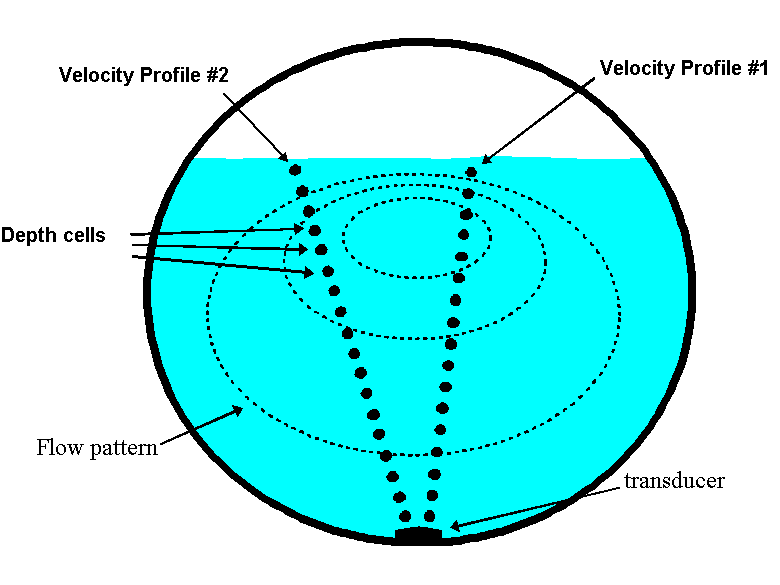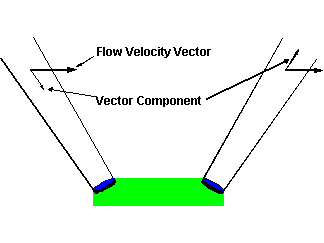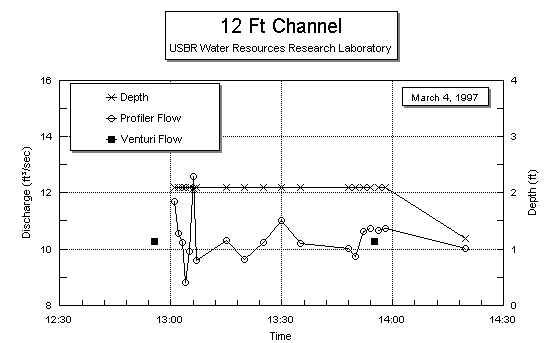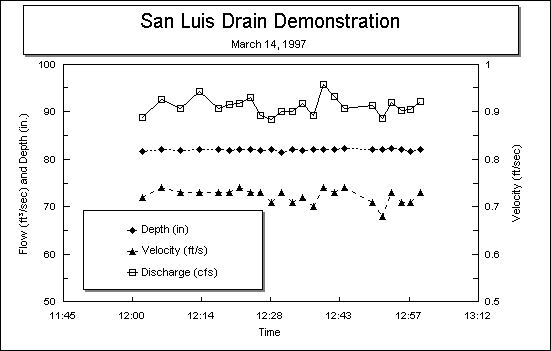
The ADFM Velocity ProfilerTM - A Report on Laboratory and Field Demonstrations Conducted for the Bureau of Reclamation
Mike Metcalf - MGD Technologies Inc.; Tracy Vermeyen - Bureau of Reclamation, Water Resources Research Laboratory; Steve Melavic, John Fields - Bureau of Reclamation, Mid-Pacific RegionMike Metcalf - MGD Technologies Inc.; Tracy Vermeyen - Bureau of Reclamation, Water Resources Research Laboratory; Steve Melavic, John Fields - Bureau of Reclamation, Mid-Pacific Region
Introduction
A new type of flowmeter, the ADFM Velocity ProfilerTM (Profiler)
was demonstrated on March 3 and 4, 1997 at the Bureau of Reclamation's
Water Resources Research Laboratory in Denver, Colorado. The demonstration
was organized by Tracy Vermeyen of the Bureau of Reclamation and Mike Metcalf
of MGD Technologies, the manufacturer of the Profiler. A subsequent field
test of the instrument was conducted in the San Luis Drain near Los Banos,
CA, on March 14, 1997. John Fields and Steve Melavic of the Bureau of Reclamation's
Mid-Pacific Regional Office were responsible for organizing this test.
This report documents the results of these tests.

Figure 1. Cross section view of typical Profiler application. This figure shows the spatial relationship of the depth cells and the profiles relative to the transducer housing.
The Instrument
Figure 1 shows a typical Profiler installation for measuring open channel
flow in a pipe. A transducer assembly is mounted on the invert of a pipe
or channel. Piezoelectric ceramics emit short pulses along narrow acoustic
beams pointing in different directions. Echoes of these pulses are backscattered
from material suspended in the flow. As this material has motion relative
to the transducer, the echoes are Doppler shifted in frequency. Measurement
of this frequency shift enables the calculation of the flow speed. A fifth
transducer is mounted in the center of the transducer assembly and is used
to measure the depth.
The Profiler divides the return signal into discrete regular intervals
which correspond to different depths in the flow. Velocity is calculated
from the frequency shift measured in each interval. The result is a profile,
or linear distribution of velocities, along the direction of the beam.
Each of the small black circles in Figure 1 represent an individual velocity
measurement in a small volume known as a depth cell.
The directions of the velocity profiles in Figure 1 are based on the
geometry of the Profiler's transducer assembly. Figure 2 shows a side view
of the transducer assembly. The profiles shown in Figure 1 are generated
from velocity data measured by an upstream and downstream beam pair. The
data from one beam pair are averaged to generate Profile No. 1, and a beam
pair on the opposite side of the transducer assembly generates Profile
No. 2.

Figure 2. Side view of the Profiler transducer assembly and its beam geometry.
Since Doppler measurements are directional, only the component of velocity
along the direction of the transmit and receive signal is measured, as
illustrated in Figure 2. Narrow acoustic beams are required to accurately
determine the horizontal velocity from the measured component. The narrow
acoustic beams of the Profiler insure that this measurement is accurate.
Also, the range-gate times are short and the depth cells occupy a small
volume - cylinders approximately 5 cm (2 in.) long and 5 centimeters in
diameter. These small sample volumes insures that the velocity measurements
are truly representative of that portion of the flow and potential bias
in the return energy spectrum due to range dependent variables is avoided.
The result is a very precise measurement of the vertical and transverse
distribution of flow velocities.
The velocity data from the two profiles are entered into an algorithm
to determine a mathematical description of the flow velocities throughout
the entire cross-section of the flow. The algorithm fits the velocity data
to the basis functions of a parametric model. The parametirc model is used
to predict flow velocities at points throughout the flow. The resulting
velocity distribution is integrated over the cross-sectional area to determine
the discharge.
The key benefit to this approach is that the system will operate accurately under variable hydraulic conditions. As hydraulic conditions change, the change will manifest itself in the distribution of velocity throughout the depth of flow. As the Profiler is measuring the velocity distribution directly, it can adapt to changes in the hydraulics, and generate a flow pattern that is representative of the new hydraulic conditions, insuring an accurate estimate of flow rate.
Test Procedure
The Profiler was first tested in two sites at the Bureau of Reclamation's Water Resources Research Laboratory in Denver: a 4-ft-wide flume, and a 12-ft-wide rectangular channel. In both lab sites, the system was installed on the bottom of the flume, centered with the transducer's long axis aligned with the flume's axis (flow direction). No in-situ calibration or rating was performed.
4 ft flume tests - The test began with a flow depth of approximately 4 ft. The depth was increased after about one hour to around 7 ft. Profiler flow measurements were then compared with the venturi meter flows to check for accuracy and repeatability.
12 ft channel tests - The test began with a depth of flow of approximately 2 ft. The depth was decreased after about one hour to about 1.2 ft. Profiler flow measurements were then compared with the venturi meter flows to check for accuracy and repeatability.
The venturi meter flows were determined using a mercury manometer to measured the pressure differential across the venturi. This manometer was manually read several times during the tests. Once set up, the flow was held constant as it was controlled by an active feedback control system. The laboratory venturi meter was calibrated prior to the Profiler demonstration. A weigh tank facility was used to calibrate the venturi meter and the uncertainty in the venturi meter measurement was within +0.8 percent of the weigh tank flow rate.
Following the laboratory tests, the Profiler was placed in a "live" channel - the San Luis Drain located near Los Banos, CA. This channel is an irrigation drain for part of the San Joaquin Valley. The channel is trapezoidal in shape, with an 8 ft bottom width and 2:1 side slopes.
The Profiler was placed on an aluminum strap about 44 ft in length. Hinges were placed on the strap so that the 8 ft. center piece would lay flat on the channel bottom and the rest of the strap would conform to the side slopes of the channel. The channel was in normal operation during the installation with a flow depth of approximately 7.2 ft.
Results
Figure 3 shows the results from the 4 ft flume tests. The round symbols represent the Profiler data and the square symbols are the spot readings from the venturi meter. As shown in figure 3, the Profiler data agrees very well with the venturi meter readings.
At the beginning of the data record there is some scatter to the Profiler data, as the flow into the flume had just been set and the depth in the flume was still equilibrating. After the first few points, the flow rate readings and depth readings become steady. The Profiler measured an average flow rate of 6.86 ft3/s during the initial depth of flow of 4 ft (after depth equilibration), compared to 6.98 ft3/s for the venturi readings during the same time period; a difference of -1.72%. We also see a change in the Profiler flow rate measurement after the level was increased to 7 ft at around 10:00 a.m. The Profiler over predicts the flow because one pair of acoustic beams intersects the walls of the flume. Consequently, the average velocity is skewed higher because it is measured near the middle of the flume where velocities are larger than near the wall.

Figure 3. Profiler and venturi flow rates measured in the 4 ft flume are plotted as a function of time. The Profiler's depth reading is also plotted to illustrate the effect of fluctuating water surface level on the discharge measurement accuracy.
The spacing on the x-axis is irregular because several sampling schemes, in which parameters such as bin size and sampling interval, were varied. In most cases, changing these parameters did not affect the overall accuracy of the flow rate measurement.
Figure 4 shows the results from the 12 ft channel test. The round symbols are the Profiler data and the square symbols are the spot readings from the venturi meter. For this test, the Profiler data were averaged over a variety of time periods. Whereas Figure 3 is a plot of "raw" flow data, where each point corresponds to a individual measurement separated by an interval varying from one to five minutes. The first seven ADFM measurements were collected with an one minute averaging interval. The average of these seven measurements is 10.48 ft3/sec. The venturi meter reading was 10.26 ft3/sec, and this flow remained constant for the remainder of the test. The next five ADFM measurements were collected with an averaging interval of 5 minutes. The average of these five measurements is 10.29 ft3/sec. The next six ADFM measurements were collected with an averaging interval of 2 minutes. The average of these seven measurements is 10.43 ft3/sec. This test demonstrates how Profiler measurements becomes more precise as the number of measurements averaged together were increased. The ability to average hundreds of flow measurements over a short period results in a very precise flow measurement. This is illustrated by comparing the average of the all eighteen Profiler measurements with the two venturi meter readings. The Profiler average was +0.97% different from the venturi meter average. The last ADFM measurement was collected with an averaging interval of 2 minutes at a depth of 1.2 ft. The measured flow rate was 10.0 ft3/sec. This measurement was made with a 10:1 width to depth ratio. This demonstrates the Profiler's unique capability to measure flows in wide, shallow channels.

Figure 4. Profiler and venturi flow rates measured in the 12 ft channel are plotted as a function of time. The Profiler's depth reading is also plotted. Initially the Profiler's discharge measurements were variable, but with time the accuracy improved to within 1 percent of the venturi-measured discharge.
Figure 5 contains a plot of the flow rate, depth, and average velocity measured in the San Luis Drain near Los Banos, CA on March 14, 1997. All three measured parameters were steady over the test period. Variations in the flow rate correlate with variations in the average velocity, as the depth remains fairly constant. The average flow rate over the duration of the test was 91.1 ft3/s. Flow rates of approximately 80 and 86 ft3/s were measured using traditional stream gaging methods. Stream gaging velocities were measured with a Marsh-McBirney Flo-Mate, which is an electromagnetic velocity meter.

Figure 5. Flow rate, depth, and average velocity plotted as a function of time. The average flow rate measured in the San Luis Drain was 91.1 cfs with a standard deviation of 2.0 percent.
The first discharge measurement was obtained by manually measuring velocities at 0.2 and 0.8 of the depth measured from the water surface, at regular intervals across the channel. These velocities were used to compute an average velocity for a particular section of the channel. Multiplying this average velocity by the cross-sectional area of the individual section gives a flow rate for that section. The section flow rates are summed to determine the total flow rate for the channel.
The second discharge measurement was obtained by making a single velocity measurement at a height above the bottom of 0.6 of full depth, at regular intervals across the channel. This value was used as the average velocity in that section to compute a flow rate for that section. Again, section flow rates are summed to determine the total flow rate in the channel. Note: This velocity measurement should have been measured at 0.6 of the depth measured from the surface not the bottom.
It should be mentioned that there was some concern over the accuracy of the manual velocity measurements. The relationship between the velocities measured at the various depths was not as expected. In particular, the velocity value measured at a height above the bottom of 0.8 of full depth, in some cases, was lower than anticipated.
Conclusions
Related links
MGD Technologies Inc. is a professional
firm specializing in the assessment of the condition and performance of
underground utility systems. The services are provided by highly trained
individuals, experienced in the innovative application of integrated, advanced
technologies. MGD's ADFM measures
the flow velocity at discrete points throughout the depth of flow.
MGD Technologies Inc.
9815 Carroll Canyon Road, Suite 200
San Diego CA 92131 USA
Tel. 619 695 9225
Fax 619 695 6890